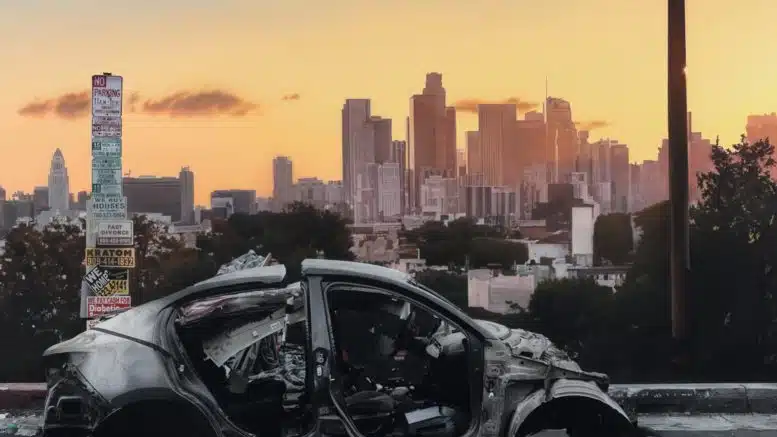Upon revisiting “Family Room,” I was struck by the revelation of two children amidst the stark scene. Positioned beneath a worn-out sign advertising “DJ,” “cocktails,” and “live entertainment,” amidst a cluttered landscape of discarded items, shattered technology, and worn-out drapes, these youngsters emerge, fully engaged in sorting through the debris.
This portrayal of dilapidation and desolation emerges from the creative mind of LA-based artist Sayre Gomez, encapsulated in his piece titled “Family Room.” Featured in his solo exhibit, “Heaven N’ Earth,” hosted at the esteemed Xavier Hufkens’ flagship gallery in Brussels, Belgium, Gomez’s work delves into the intricate dynamics of urban life, capturing the essence of his hometown in a remarkably realistic manner.
Speaking remotely via Zoom, Gomez disclosed the deliberation behind incorporating figures into his painting, revealing that their presence was inspired by a real-life family inhabiting makeshift shelters near his studio. Through his artwork, these children serve as a poignant symbol of the broader societal challenges, embodying the struggles faced by marginalized communities.
Spanning across four floors, Gomez’s exhibition juxtaposes serene Californian vistas with the harsh realities of construction sites and abandoned vehicles engulfed in flames. His artistic focus on the survival tactics amidst the onslaught of capitalist development reflects a genuine effort to immortalize the lived experiences amidst the aftermath of industrial decline.
Acknowledging the evolution of his artistic expression, Gomez, now a father himself, concedes to a perceptible shift towards darker themes in recent years, echoing the societal transformations he’s witnessed. Despite infusing elements of childhood innocence into his work, the prevailing atmosphere remains tinged with melancholy, emblematic of the artist’s struggle to cling onto hope.
Among Gomez’s notable pieces, “Lights, Camera, Action,” serves as a stark reminder of the stark contrast between Hollywood’s glitz and the grim reality of tent-lit homelessness rampant in LA. Reflecting on the city’s pervasive homelessness issue, once confined to Skid Row but now pervasive across various neighborhoods, Gomez acknowledges the unavoidable presence of this social crisis.
Having originated from Chicago and later settling in Los Angeles for his studies, Gomez found artistic inspiration amidst the city’s vibrant culture and diverse artistic influences. His signature hyper-realistic style, influenced by local luminaries and the entertainment industry, reflects his deep-rooted connection to the city’s creative milieu.
Beyond painting, Gomez’s artistic endeavors extend into the realm of sculpture, blurring the boundaries between reality and artifice. Pieces like “The Promise,” a 3D-printed recreation of a charred electric vehicle charging station, and “Scale Replica of the Past, Present, and Future (Peabody Werden House),” encapsulate the artist’s reflections on gentrification and displacement within LA’s suburbs.
Amidst the prevailing narrative of urban decay, Gomez’s affection for California remains paradoxically intact, acknowledging the state’s intrinsic beauty amidst the surrounding desolation. Despite portraying grim realities in his artwork, Gomez’s unwavering connection to his hometown underscores a profound appreciation for its intricate tapestry of contradictions and complexities.

